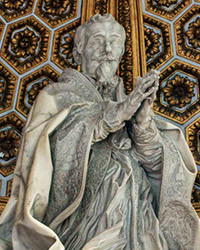
Silver medal showing the portrait of the pope Clement IX

Silver medal showing the bridge S.Angelo - work of Pope Clement IX

Tombstone monument of Pope Clement IX, fragment, Basilica of Santa Maria Maggiore

Tombstone monument of Pope Clement IX, Basilica of Santa Maria Maggiore

Portrait of Pope Clement IX, Palazzo Chigi, Ariccia, pic. Wikipedia

Portrait of Pope Clement IX, Galleria Nazionale d’Arte Antica, Palazzo Barberini
His motto was: “Clement to others not to himself”.[1] And it must be admitted that during his over two-year-long pontificate Clement IX was up to this challenge. He displayed care and love towards the sick and the poor, spreading among them the word of God and bringing them blessings, the Holy Communion, and even soup (Ospedale di San Spirito). Thus, he was loved by the Roman populace, which after the death of their pope visited his tomb in throngs and gave him the honor befitting a saint.
His motto was: “Clement to others not to himself”.[1] And it must be admitted that during his over two-year-long pontificate Clement IX was up to this challenge. He displayed care and love towards the sick and the poor, spreading among them the word of God and bringing them blessings, the Holy Communion, and even soup (Ospedale di San Spirito). Thus, he was loved by the Roman populace, which after the death of their pope visited his tomb in throngs and gave him the honor befitting a saint.
Before he ascended to St. Peter’s throne, Giulio Rospigliosi exhibited an interest in humanities. He wrote poems and librettos for musical pieces of a comic (opera buffo) as well as moral and sacral character, combining recitative parts with music and theatre, choir and group scenes, contributing to the development of opera music of those times. As a protégée of the Barberini family, between the years 1631 and 1634 he wrote several opera librettos, of which the most famous are the musical drama Sant’Alessio (1631) and the comic opera Chi soffre, speri (1639). He had a special place in his heart for castrati, it was for them that he created his pieces and it was them that he – as pope – entrusted with political and diplomatic missions.
He was also an enthusiast of the visual arts, which is testified to by his foundations, although not as spectacular as those made by his predecessor, Alexander VII, who emptied out the whole treasury due to all his projects. Clement IX completed the decoration of the colonnade on St. Peter’s Square (figures of the saints) begun by Alexander, however his principal foundation was the enrichment of the Sant’Angelo Bridge with magnificent statues of angels holding the symbols of Christ’s passion. Both of these projects were the work of Gian Lorenzo Bernini. And while the first figures adorning the monumental colonnade gave evidence to the greatness of the Church, the Stations of the Cross on the Bridge of the Holy Angel were to restore a spirit of religious zeal which was propagated by Clement IX and which had lost all of its appeal in the previous centuries.
He was not elected as pope until the eighteenth day of the conclave as a compromise candidate for two warring factions: Pro-French and Pro-Spanish. He had good relations with both the nepots of Alexander VII and the representatives of the Curia, chosen by his predecessor. However, even he fell to the temptation of nepotism, while his relatives from the well-known Lombard Rospigliosi family occupied several significant posts in the State of the Church, although they never attained the status of nepots of previous popes.
Clement IX died of an apoplexy attack and was buried in the Basilica of San Pietro in Vaticano. He is remembered in history as a man of impeccable character, modest and compassionate, which was an exception among the popes of those times. Later (1675) his remains were transferred to the Basilica of Santa Maria Maggiore, over which he presided as titular cardinal prior to becoming pope and where he had desired to be buried. It is there, immediately above the entrance, that we can find his rather modest for those times funerary monument completed by Carlo Rainaldi in 1671.
[1]Translator’s note: this was a pun on his name since his birth name was Giulio and also a reminder not to be as forgiving to himself as he was to the faithful




















